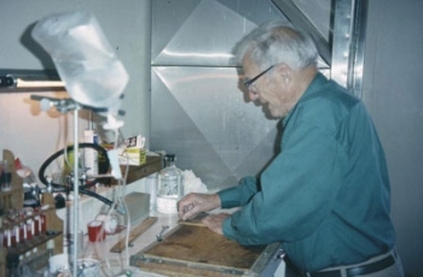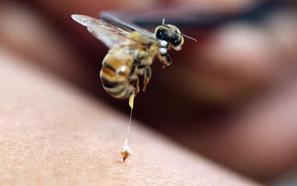|
Charles Mraz was recognized in the United States as the pioneer of bee venom therapy: the use of bee stings to treat various disorders, primarily autoimmune diseases. In addition to initiating clinical research with scientists at the Sloan-Kettering Institute and the Walter Reed Army Institute, he established the standard for purity for dried whole venom for the U.S. Food and Drug Administration and was the supplier of venom to pharmaceutical companies throughout the world.
A founding member of the American Apitherapy Society, Charlie earned the gratitude of thousands of people who traveled to his home in Vermont for bee venom treatments or met him at apitherapy conferences around the country. His 1994 book, Health and the Honey Bee recounted his experience with bee venom therapy. |
Words from Dr. Charles MrazExcerpt from Bee Venom Therapy: Bee Venom, Its Nature, and Its Effect on Arthritic and Rheumatoid Conditions"To this day one of the most difficult problems with bee venom therapy is to make people understand that this “bad reaction” is NOT bad-it is a “good reaction,” and most important to the improvement of the patient...
"Usually there is not much swelling from the venom at first, but later the treatment will produce much swelling, redness, itching, and heat. Also, more pain may be experienced, and perhaps even nausea, which can be most discouraging to arthritic patients, who may want to quit. It is most important to remember that this “reactive stage” is the most essential part of the treatment-it is an indication that the “immune system” is being stimulated to produce the healing processes. The treatment must continue. After about two weeks of this “reactive period,” there is the stage of “resistance.” This is when the body develops a resistance to the bee venom and will no longer swell when bee venom is injected. After the stage of resistance is reached, the treatments are usually terminated. If there is relief, the bee treatment does not need to be applied again until symptoms recur, which may be years later or not at all." |
Common Reactions from Bee Venom Therapy
Bee venom is safe for most people when injected under the skin by a trained medical professional. Some people might get redness and swelling where the injection is given.
Side effects are more common in people with the worst allergies to bee stings, in people treated with honeybee venom, and in women.
Live bee stings have been safely administered under medical supervision in doses up to 20 bee stings three times weekly for up to 24 weeks.
Special Precautions & Warnings
Pregnancy and breast-feeding:
Bee venom seems to be safe when injected under the skin by a trained medical professional at recommended doses. Though harmful effects at usual doses have not been reported, some healthcare providers decrease the maintenance dose by half during pregnancy. High doses of bee venom are UNSAFE during pregnancy because they can increase release of a chemical called histamine, which can cause the uterus to contract. This might lead to miscarriage. Avoid high doses of bee venom and consult a physician if you are pregnant or breast feeding.
- Most reactions are mild. You may see redness, mild swelling, heat and itching in the area of the injections. These reactions are expected and a part of the treatment. Such reactions can last from a few minutes to 2-5 days and are self-limiting (meaning they go away by themselves). At times, flu-like symptoms may occur lasting several days. These are still considered normal -- they let you know that the body is going through a fighting/healing response. It is best to do nothing and just observe and tolerate the reaction, allowing the body to go through the healing process.
- Some more major side effects include itching, anxiety, trouble breathing, chest tightness, heart palpitations, dizziness, nausea, vomiting, diarrhea, sleepiness, confusion, fainting, and low blood pressure.
Side effects are more common in people with the worst allergies to bee stings, in people treated with honeybee venom, and in women.
Live bee stings have been safely administered under medical supervision in doses up to 20 bee stings three times weekly for up to 24 weeks.
Special Precautions & Warnings
Pregnancy and breast-feeding:
Bee venom seems to be safe when injected under the skin by a trained medical professional at recommended doses. Though harmful effects at usual doses have not been reported, some healthcare providers decrease the maintenance dose by half during pregnancy. High doses of bee venom are UNSAFE during pregnancy because they can increase release of a chemical called histamine, which can cause the uterus to contract. This might lead to miscarriage. Avoid high doses of bee venom and consult a physician if you are pregnant or breast feeding.
What can you do if you cannot tolerate the temporary discomfort of these reactions?
- Take plenty of vitamins and supplements (as recommended by your bee venom therapy practitioner)
- Massage skin with a soft brush over the itchy area to provide temporary relief
- Apply an ice cube, cold compress, household ammonia or baking soda as a paste over the effected area
- Apply Preparation H cream (anti-itch cream with hydrocortisone 1%) to the skin in the area of the skin; another option is to rub a little meat tenderizer into skin (however, these options will diminish the effect of the bee venom)
- Avoid benydryl, calimine, antihisamines, and NSAID's (like Motrin, Naprosyn, and Tylenol) as they will block the effect of the bee venom



